Sword 2000 was a spectacular success. Without a doubt, Sword 2000 was
one of the most important events ever put together for the exploration of the Medieval
sword. For two and a half days over September 15-17, the beautiful camp Ashokan isolated
in the Catskills outside of Kingston, New York, was the setting for a gathering of over 75
blade and sword fanatics focusing on the ethnographic study of historical cutting swords.
This was the 2nd exclusively "Sword" event in 5 years sponsored by the New
England Bladesmith’s Guild and the guild’s 19th annual gathering.
|

Dan Maragni gives a lecture
|

John offers an impromptu
demo on grip change in cutting |

ARMA demo |
This was not an event
concerned with mass production replicas, movie or fantasy swords, or theatrical and
sporting blades, but only functional weapons –real swords. This was not simply
a convention of collectors or historical arms dealers or of historical fencers and
reenactors, although all were represented, it was a group if individuals who recognize the
importance of studying the historical significance and creation of the weapons and their
usage. The central idea stressed repeatedly throughout the event was the study of the
sword not as simply an historic artifact or icon, but the sword in its historical role as
a technological and military construct, or as was repeatedly said, the sword as a long-bladed
hand tool. Topics included the cutting sword in relation to its technology,
engineering, forensics, anthropology, and battlefield applications. |

Dan Maragni gives a demo on smithing
|
Event coordinators, Dr. Lee Jones and Dan Maragni
did a fantastic job of bringing together a range of some
highly knowledgeable persons in the field of European swords
examining the swords from all angles of history, usage,
design and manufacture. The capacity crowd of attendees
were treated to informal discussions and trading, bartering,
buying and selling of blades and related items, tasty onsite
meals, and open sessions lasting nearly until dawn before
retiring to the bunkhouse. The summer-camp style gathering
of Sword 2000 encouraged communication and genuineness among
all the attendees and extended to a Saturday night bonfire
following the tempering of a blade. The event’s constant
schedule was composed of a combination of slide shows on
sword typology and archaeology, martial demonstrations of
test cutting and fighting skills, and assorted antique blades
made from 1000 BCE (!) to 1950 were also displayed
in hands-on viewing sessions. This hands-on session gave
the gathering a personal sense of discovery far more than
a typical visit to a museum and rounded out the very unique
two and a half non-stop days of sword study.
|

Working with hot steel
|
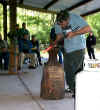
The craftsman's skills |
The gathering’s focus was the Medieval Sword
–and specifically cutting blades. For the collectors,
artists, bladesmiths, and sword enthusiasts present the
sole interest was in the ancient craft of historical sword
production rather than in modern methods. For the first
time, a unique approach to the subject was offered by this
combination of quantitative and holistic aspects of examining
and evaluating historical specimens (plus historically accurate
modern reproductions). The assembled metallurgists, blade
makers, and engineers had opportunity to discuss the science
of Medieval cutting swords while the artists, craftsmen,
and practitioners, provided their own perspectives on design
and application.
|

The magic of flame and steel |

Paul Champagne gets into it |

A master at work |
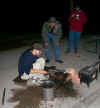
Forging a new blade |

The night broken by the red glow of a sword's birth |

The finished product emerges red hot
|

Letting the charcoal
fire work its magic |
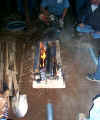
The tempering process of a blade in heated oil |
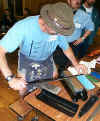
Philip Baldwin
sharpens his
creation |

John tries out a two-hander from c. 1550 (definitely not
"his" weapon) |
ARMA Director and chief
instructor, John Clements, was invited to demonstrate aspects
of Medieval European sword use. Along with Deputy Director
and senior ARMA student, Jeff Basham, John put on two demonstrations
of various sword fundamentals placing focus on functionality
and design. John and Jeff also emphasized how function affected
forms as well as vice versa. The use of single-hand short
swords and shields as well as armor was addressed as were
differences in military and civilian blades. John commented,
"With the real swordmakers, we emphasized real sword
fighting. We stressed how movies and television sword fights
repeatedly misrepresent the handling of the weapons and distort
how swords actually function, so that these pervasive (and
influential) depictions can’t be looked on for inspiration."
The audience was in total agreement. |

A great day for swordplay |

Sword vs. Long-sword
|

Sword vs.rapier
|

Examining a steel blunt replica |
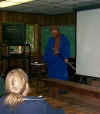
Dr.Jones masquerades |
On Friday evening the event
began with bladesmith, Dan Maragni, self proclaimed sword
nut and consultant to the industry cutlery, presenting the
opening slide show on "Physical Characteristics of European
Cutting Swords 250 BC-1200 AD". Dan gave a lively and
often humorous discussion of cross-sections, weights, profiles
and hilt-construction techniques used for cutting swords from
the Celts to the Normans. Later that night Dan gave the first
demonstration on "Bloomery Smelting" –a brief
explanation, which was the primary method of iron and steel
production in the periods under discussion, followed by video
examples of contemporary Japanese and African bloomery smelting.
|

Dr. Jones covers sword types |
On Saturday, Dr. Lee Jones, a forensic pathologist
and avid sword enthusiast, presented a lecture on "Early
Evolution of the European Longsword" - an illustrated
review of the evolution of the weapon from its origins to
the close of the Medieval period (complete with slides of
Oakeshott’s typology and sample pieces). Afterwards,
the event moved outside again where Dan Maragni gave a demonstration
of "European Sword Forging" - covering the techniques
used to create a typical European style fullered blade using
modern equipment and materials. Dan pounded out a sword
shape from steel to the intense gaze of the assembled onlookers.
|
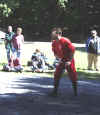
The nature of steel |
Following this, John and Jeff demonstrated a reconstruction
of ARMA’s Medieval European fighting skills and discussed
the current revival of Western martial culture. Jeff and
John conducted an introduction to European sword arts of
the 1400s & 1500s and gave a two-hour comparison between
Medieval and Renaissance methods. "The enthusiastic
response from the event guests and presenters was quite
a rush," Jeff said. John commented, "I was proud
to have been a part. I was surprised at how well received
we were and by what a reputation for serious competence
ARMA already had among the attendees." "We learned
a lot and we shared a lot," John observed.
|
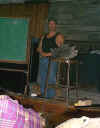
Paul and his prize chunk
of smelted iron ore
|
After lunch, sword-maker, Paul Champagne, gave a
presentation on "Evolution of the Japanese Sword"
- discussing the physical characteristics of the Japanese
sword and how it changed over time to adapt to changes in
armor and fighting styles. Paul is a dynamic speaker who
made a point to stress the myths and hype of Japanese swords
in contrast to the reality of how they developed and were
produced. Paul is widely known for forging the katana recently
used by master swordsman, Toshishiro Obata, to set a new
record for test-cutting on a period helm. Paul says first
love however is European swords and it is the accurate reproduction
of these which his skills are currently focused on.
|
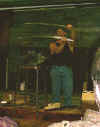
Paul Champagne compairs blades |
After his lecture, Paul Champagne gave an outside
demonstration of "Japanese Sword Forging" techniques
adapted to modern equipment and materials. Using the prearranged
furnace and tools, Paul went to work under the watchful
eyes of the surrounding attendees. Following this, practitioner
Tom Walter conducted "Tameshigiri" - a discussion
and demonstration of traditional Japanese test cutting using
the katana on dried bamboo and wet straw mats.
|
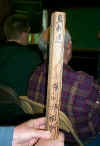
A sample 2x4 cut 3/4ths through by Toshishiro Obata using Paul's blade |
Following dinner, Dr. Jones offered insight into
"Ethnographic Swords: Persistence, Reoccurrence and
Innovation" – a presentation focusing on the persistence
and reoccurrence of the straight, double edged form of sword
in many cultures and also considered many of the unique
forms which have developed in various cultures at various
times. For this, and the subsequent viewing of North African
blades, Dr. Jones dressed up in a an authentic garb of a
modern Saharan Bedouin tribe that still to this day wear
swords as part of their daily dress.
Following
this, bladesmith, Tim Zowada, gave a fascinating lecture and slide presentation on
"High Tech. Heat Treatment" focusing on the tempering of long blades using
kilns, salt pots and digital temperature controllers. Tim set up a furnace, created
charcoal, and began the process while flame and sparks flickered and flew into the
darkness. Immediately following Tim Zowada, Phillip Baldwin demonstrated "Low Tech.
Heat Treatment" of long blades using a simple firebrick forge and charcoal. The
attendees watched as the blade was soaked in oil and tempered over the open pit furnace. |

Cleaving a dead branch
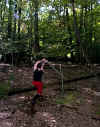
Hacking through a standing post |
On Sunday, following breakfast, Dan Maragni presented
a slide show entitled "Violent, Bloody Death"
- a sobering look at the contemporary literature of eyewitness
accounts of the effects of edged weapons on the human body
and a sampling of slides showing these effects on ancient
skeletal remains from the famed Wisby find (including showing
a reproduction of one the infamous "Wisby skulls").
Dr. Jones offered his thoughts on the physiology of sword
wounds throughout the weekend. Afterwards, John & Jeff
gave a second fighting demonstration discussing reconstruction
of Renaissance blade forms and their associated fighting
techniques.
The exchange of information between active users
and serious producers was dynamic and extremely helpful
all around on each side. John added, "It was great
to be able to finally meet fellow sword nuts such as Dan
and Lee who I have been corresponding with for so long and
only knew through emails and phone calls." Jeff observed,
"It was very exciting to be on hand and asked at every
step of the way to offer insight into the tools based on
study of how they were really used. These craftsmen had
no doubt their product was intended to be a real sword and
really capable of holding up to historical abuse. They could
care less about wall-hanger and fantasy pieces. It was honestly
very exciting."
|

Examining antique blades

Actual ancient & Medieval swords on display |
At one point during the weekend, John also got to
test cut with a very highly accurate replica Norman sword
prototype and give feedback to the makers (thereby fulfilling
one of the very aspects stressed throughout the weekend
–the interaction of experienced maker with skilled
user). "Yes, I killed several pieces of hard wood –maple,
birch, cherry, sacrificing 6 or 8 of them to further our
study. This sword was one of the absolute best replicas
I have ever used, hilt and blade combined. Any time I’m
asked to abuse a good blade I’m thrilled, test-cutting
with one this superb was a highlight of the weekend for
me," said John. Another of the gathering’s highlights
was the chance to witness actual smelting of raw iron ore
into useable nuggets; see these turned into steel, and witness
steel bars heated and forged into blades which were later
tempered and finally honed sharp. It was an amazing process
of creation which still retains an element of "magic".
To then be able to handle the final (un-hilted) blade and
even try a hand cutting with it was truly unique.
|

In the viewing room
 |
Although the overall focus of the event was Medieval
European blades designed for cutting, the weekend included
a wide range of ethnographic blades. On-hand were varieties
of antique weapons ranging from North Africa, East Africa,
the Middle East, Asia Minor, Turkey, Central Asia, Indo-Persia,
Indonesia, Malaysia, the South Pacific, Nepal, Burma, China,
Japan, and South America. One of the highlights was the
presentation of several blades in excess of 1000 years old
including actual Celtic and Roman weapons. Several examples
of Viking, Germanic, and Norman pieces were also presented
from private collections. Some were in excavated condition,
and others were still battle-worthy. The swordmakers swarmed
over the weapons with scales, calipers, and rulers measuring
cross-sections, weights, tapers, balance points, etc. John
and Jeff contented themselves with hefting them, posing,
and swinging a few around. As Jeff exclaimed, "Finally,
I got to handle real swords!"
|
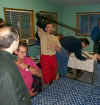
Real 17th century basket-hilt broadsword with 16th century German
blade
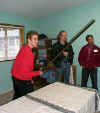
"It's definitely you"

|
As John observed, "I was amazed at how much
there was to learn. I have never professed any knowledge
of swordsmithing, blademaking or metallurgy, (I can't even
repair my loose hilts). Being in the presence of such expert
craftsmen and experienced artists was incredible. As practitioners
and researchers, as martial swordsmen it was a thrill."
Another thrill was learning (no big surprise) how virtually
everything we’ve seen in the movies regarding how swords
are made is garbage. The actual process is much different.
There’s no pouring of molten metal and not as much
banging on a red-hot blade, plus the tempering process is
delicate and slow. Another rare opportunity was in witnessing
a sword sharpening. Blades were polished using both blade
on stone and stone on blade methods and the differences
between knife and sword edges were discussed.
For the first time ever, a meeting of expertise
in history, construction, and application of Medieval swords
was brought together for a weekend of intense exploration
starting after 8 am and going on past midnight. The entire
range of swords were examined from their definition and
idea, to their metallurgy, technical geometry, edge-configuration,
hilt design, wound physiology, and methods and techniques
of application. It was a significant achievement. John noted,
"Given the event’s success plans are underway
to host another similar one very soon."
The triangle of knowledge is now complete: practitioners, scholars, and
swordmakers are finally coming together to learn about real swords. That was what Sword
2000 was all about!
|

John & Jeff doing counters |
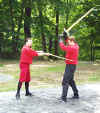
Discussing real range |

Practice in the woods |

Practice on a hill |
 |
 |
 |
 |
 |
 |
 |
|
|


